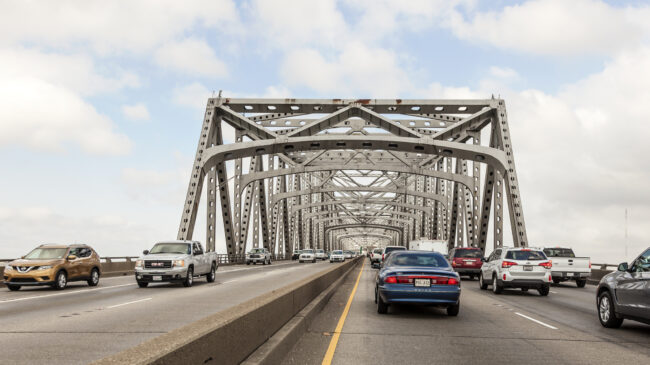A version of this testimony was delivered to the Louisiana Joint Transportation Committee. The hearing can be viewed here.
My name is Jay Derr. I was born and raised in Louisiana and have lived in the state my entire life. I graduated from Louisiana State University with a bachelor’s degree in political science. I am a Transportation Policy Analyst at Reason Foundation, a 501(c)(3) nonprofit think tank. Reason’s transportation experts have advised federal, state, and local policymakers for almost four decades on transportation matters. My testimony draws on my experience and research.
Louisiana Needs a Replacement Bridge
The Calcasieu River Bridge opened in 1952 as part of a U.S. highway and grandfathered into I-10. The bridge was designed with a 50-year lifespan in mind, yet the bridge is 71 years old and still operating. Designed for 50,000 vehicles per day, the bridge now carries more than 90,000. Dr. Eric Kalivoda, secretary of the state’s transportation department, told a panel at the Calcasieu River Bridge Public Meeting in August that the bridge’s traffic is projected to grow considerably over the next 20 years, with “110,000 [crossings] per day” as soon as 2042.
Since it was not designed as an Interstate bridge, the Calcasieu River Bridge falls short of Interstate design standards, with its narrow lanes and limited shoulders leading to increased traffic crashes.
The Federal Highway Administration has found the bridge to be structurally deficient. A 2017 Purpose and Need Technical Memorandum issued by the Louisiana Department of Transportation and Development and the Federal Highway Administration (FHWA) flagged several structural deficiencies in the bridge’s substructure and superstructure that would require “maintenance and repair to remain in service and eventual rehabilitation or replacement to address deficiencies.”
The FHWA uses a scale from zero to nine to evaluate deterioration, where zero indicates an infrastructure element has failed, and nine indicates it is in excellent condition. In the Purpose and Need Technical Memorandum, four elements of the Calcasieu River Bridge were rated at four or below, signifying poor or severe deterioration of the west and east approach superstructures and substructures, the main bridge superstructure, and the east approach deck.
In effect, we have a bridge past its design life and overburdened at a critical point in I-10, where traffic is projected to grow yearly.
Benefits of a Public-Private Partnership Approach for Louisiana
Public-private partnerships (P3s) such as this proposal are widely used in other countries, such as Australia, France, and the United Kingdom. According to the World Bank, since 1990, there have been 1,317 P3 projects in the highway sector. Including all other sectors, this number balloons up to 8,805.
This would not be Louisiana’s first P3, nor its first P3 bridge. The Belle Chasse Bridge and Tunnel Replacement Project was the first P3 sought by the Department of Transportation and Development (DOTD) and was approved by this committee in 2017. That project aimed to revitalize and replace two critical, primary access points for the residents and businesses in Plaquemines Parish and is on the path to do so.
While many Lake Charles businesses and residents have expressed concern about P3s, this project would benefit local workers, the DOTD, the trucking community, and Louisiana taxpayers.
For workers, most jobs the public-private partnership would create would be in Louisiana. According to a recent Reason Foundation study, “Contractors and Transportation Public-Private Partnerships,” payments to local subcontractors averaged 54% of the total spending in project budgets in U.S. transportation P3s, with 230 unique subcontractors per project. Calcasieu Bridge Partners, the concessionaire selected for the project, has repeatedly stressed its prioritization of local workforce development and planned use of Southwest Louisiana subcontractors and suppliers. Calcasieu Bridge Partners also assured the Lake Charles community they plan to use and provide workforce development opportunities for relevant apprenticeships in the region once their contractually required workforce plan is finalized.
For the Louisiana DOTD, a major (and needed) highway modernization will be completed using less of our state’s transportation budget, allowing a larger portion of that money to pay for expanding and maintaining other highways in Lake Charles and around the state. Calcasieu Bridge Partners would also provide 50 years of guaranteed maintenance as part of the contract, freeing up more of the DOTD’s budget. For bridge conditions, the private partner is held to a higher standard (smoother pavement, fewer potholes, etc.) than the state.
For I-10 drivers and truckers, a new toll bridge will be constructed to replace the obsolete and congested bridge. It will likely have a 100-year lifespan and sufficient capacity to accommodate projected traffic growth, eliminating the current bottleneck where six lanes converge into four. For those seeking to avoid the toll, I-210 provides a toll-free alternative route, which is 13 miles long, compared to the existing bridge’s 10 miles, and only takes drivers about three extra minutes than travel using the bridge.
And finally, for Louisiana taxpayers, the financial risks that come with major infrastructure projects, including the financial burden of any cost overruns, are transferred to the private sector partner. A study by McKinsey and Company found that 98% of megaprojects experience cost overruns and delays of up to 20 months. Protecting taxpayers from bearing these costs is paramount and should be one of the state’s top priorities.
Conclusion
Louisiana cannot afford to pay the total price of building and maintaining a $2.1 billion bridge, so financing options are the best means of project delivery for this needed infrastructure. Well-executed long-term revenue-financed P3s are wise public policy and can be used to great effect, especially for megaprojects like this bridge. As explored, they also bring a host of benefits to the state and its people.
The proposed public-private partnership replacement of the Calcasieu Bridge on I-10 near Lake Charles is a wise financial decision for the state’s current needs and provides a framework for future P3s Louisiana may wish to pursue in response to its needs. I believe this committee ought to approve the proposal laid out before today.

